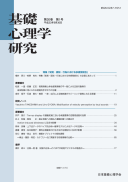Volume 17, Issue 1
Displaying 1-16 of 16 articles from this issue
- |<
- <
- 1
- >
- >|
-
Article type: Cover
1998 Volume 17 Issue 1 Pages Cover1-
Published: September 30, 1998
Released on J-STAGE: November 16, 2016
Download PDF (1901K) -
Article type: Cover
1998 Volume 17 Issue 1 Pages Cover3-
Published: September 30, 1998
Released on J-STAGE: November 16, 2016
Download PDF (78K) -
Article type: Article
1998 Volume 17 Issue 1 Pages 1-11
Published: September 30, 1998
Released on J-STAGE: November 16, 2016
Download PDF (988K) -
Article type: Article
1998 Volume 17 Issue 1 Pages 12-19
Published: September 30, 1998
Released on J-STAGE: November 16, 2016
Download PDF (992K) -
Article type: Article
1998 Volume 17 Issue 1 Pages 20-26
Published: September 30, 1998
Released on J-STAGE: November 16, 2016
Download PDF (727K) -
Article type: Article
1998 Volume 17 Issue 1 Pages 27-35
Published: September 30, 1998
Released on J-STAGE: November 16, 2016
Download PDF (1171K) -
Article type: Article
1998 Volume 17 Issue 1 Pages 36-40
Published: September 30, 1998
Released on J-STAGE: November 16, 2016
Download PDF (660K) -
Article type: Article
1998 Volume 17 Issue 1 Pages 41-42
Published: September 30, 1998
Released on J-STAGE: November 16, 2016
Download PDF (254K) -
Article type: Article
1998 Volume 17 Issue 1 Pages 43-44
Published: September 30, 1998
Released on J-STAGE: November 16, 2016
Download PDF (275K) -
Article type: Article
1998 Volume 17 Issue 1 Pages 45-46
Published: September 30, 1998
Released on J-STAGE: November 16, 2016
Download PDF (250K) -
Article type: Article
1998 Volume 17 Issue 1 Pages 47-48
Published: September 30, 1998
Released on J-STAGE: November 16, 2016
Download PDF (268K) -
Article type: Article
1998 Volume 17 Issue 1 Pages 49-50
Published: September 30, 1998
Released on J-STAGE: November 16, 2016
Download PDF (258K) -
Article type: Article
1998 Volume 17 Issue 1 Pages 51-52
Published: September 30, 1998
Released on J-STAGE: November 16, 2016
Download PDF (275K) -
Article type: Article
1998 Volume 17 Issue 1 Pages 52-56
Published: September 30, 1998
Released on J-STAGE: November 16, 2016
Download PDF (694K) -
Article type: Article
1998 Volume 17 Issue 1 Pages 57-62
Published: September 30, 1998
Released on J-STAGE: November 16, 2016
Download PDF (721K) -
Article type: Article
1998 Volume 17 Issue 1 Pages 62-67
Published: September 30, 1998
Released on J-STAGE: November 16, 2016
Download PDF (971K)
- |<
- <
- 1
- >
- >|
